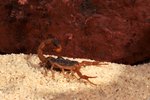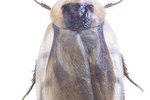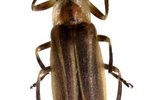
The brown marmorated stink bug, often called just the stink bug, is in the insect family Pentatomidae. When aggravated, the bug releases a foul-smelling odor, which gives the bug its common name. First found in China, Korea and Japan, the brown marmorated was noted in the United States in the 1990s. Now almost every state has reported sightings of the bug.
Description
The shape of the brown marmorated stink bug helps to identify it from other bugs. Viewed from above, the bug is almost as wide as he is long and is shaped like a shield. The stink bug grows to approximately a half-inch long. The top and bottom of the bug are brown; distinguishing light-colored bands appear on the antennae and the area that overlaps at the rear of the front pair of wings.
Reproduction
Breeding occurs in the spring and females generally lay their eggs when the weather is warm. The brown marmorated stink bug female lays about 25 eggs in a cluster. They prefer to deposit the eggs on the underside of vegetation and leaves. After hatching, the nymphs that look like small ticks stay near the mass for several days. They undergo five stages, lasting about one week each, when they molt and regrow the outer shell as nymphs.
Life Cycle
According to the University of Florida website, the brown marmorateds become sexually mature approximately two weeks after the nymphs undergoes their final molt. Adult brown marmorated bugs live about six to eight months, according to the Rutgers website. Brown marmorateds produce only one generation per year. During their lifetimes, females may produce up to 400 eggs each.
Facts
During the fall, as it becomes cooler, the bugs seek warm shelter, like residential homes. When a stink bug finds a suitable home, it releases aggregation pheromone that attracts other stink bugs to the area. Brown marmorateds are not harmful to humans and do not sting or bite. However, they are pests to agricultural farmers, since they feed on vegetables, and fruits including pears and apples.
References
Resources
Photo Credits
-
Medioimages/Photodisc/Photodisc/Getty Images
Writer Bio
Amanda Maddox began writing professionally in 2007. Her work appears on various websites focusing on topics about medical billing, coding, real estate, insurance, accounting and business. Maddox has her insurance and real estate licenses and holds an Associate of Applied Science in accounting and business administration from Wallace State Community College.



